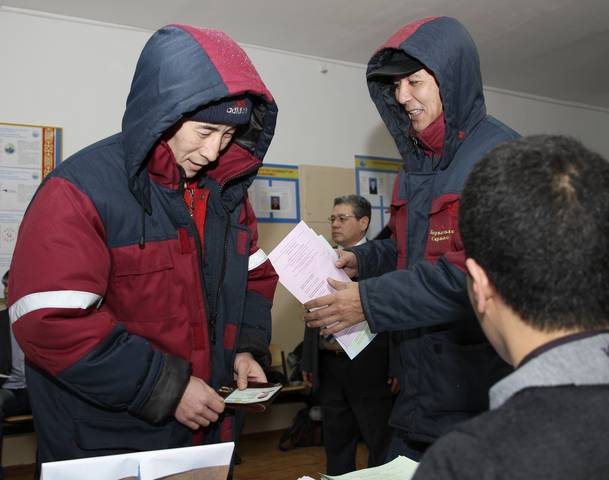
Elections in Zhanaozen Peaceful, But Concerns Remain
Publication: Eurasia Daily Monitor Volume: 9 Issue: 11
By:

Kazakhstan held parliamentary and local elections a month after clashes between protesting oil workers and police left 17 dead in the western city of Zhanaozen on December 16, 2011. The violent riots followed by police shooting took place on the day Kazakhstan celebrated the twentieth anniversary of its independence, which coincided with the official start of the election campaign.
Kazakhstan’s parliamentary elections resulted in a multi-party national assembly, effectively ending the one-party parliament in the country. Since 2007, Kazakhstan has had a one-party parliament, which was a major cause for international criticism, particularly during Kazakhstan’s tenure as chairman of the Organization for Security and Cooperation in Europe (OSCE).
The presidential party Nur Otan will still dominate the next parliament after receiving 80.7 percent of the vote, but the business party Ak-Zhol and the Communist People’s Party managed to pass the threshold of 7 percent and are expected to send 10 representatives each to the 107 member national assembly (Kazakhstanskaya Pravda, January 16). Although Ak-Zhol was the likely second party in the next Majilis, the Communist People’s Party also managed to pass the threshold by running a dynamic and innovative election campaign targeting young voters. The political parties competed for 98 seats of parliament while the Assembly of the Nations of Kazakhstan elected nine members to represent the country’s over 100 ethnic minorities.
The OSCE nonetheless said that notwithstanding the Kazakh government’s stated ambition to strengthen the democratic process, the January 15 parliamentary vote failed to meet international standards. The Kazakh government is contesting the harshly critical OSCE statement that has not noted the success in electing a multi-party parliament (VOA, January 17). As the OSCE report acknowledged that in 92 percent of the polling stations voting went well, most irregularities were reported during the counting of the ballots. The more serious shortcomings listed by the OSCE concern the electoral legal framework and the ability of the political parties to assemble, register, and participate in the electoral contest.
The elections in Zhanaozen were conducted under a state of emergency and closely monitored by international election observers and the media. Although the voting went peacefully, the city remains tense and questions about the tragic events are looming among the local citizens as the authorities investigate the incident.
A state of emergency was initially announced from December 16, 2011 until January 5, 2012, but it was subsequently extended through the end of January. The Central Election Commission decided on January 6 to cancel the parliamentary vote and postpone the local elections based on the opinion of the Constitutional Council (Trend, January 6). But President Nursultan Nazarbayev objected to the decision, which would have infringed on the people’s right to elect and be elected, and poll was reinstated. According to Kazakh press reports and discussion with local citizens of Zhanaozen during a trip to the city by the author to monitor the election there many residents of the city seemed to be satisfied with the decision to hold elections regardless of the state of emergency (Author visit to Zhanaozen, January 15).
Turn out in Zhanaozen was 63 percent, lower than the usual 80-85 percent turnout in previous elections, indicating that the violent clashes have impacted people’s desire to participate in the poll. Support for the ruling party was also lower – 70 percent compared to the national level of 81 percent. Unlike the national election results, the Social Democratic Party, considered the only truly opposition party in the electoral contest, came second, followed by Ak-Zhol (City Election Commission, January 16).
The city of Zhanaozen is still in shock after the violence in December and many refused to talk to the media on election day. According to the commandant of the city Amanzhol Kabilov, appointed to oversee the state of emergency, 2,000 policemen provide security and there are seven checkpoints around the town. Police were visible on the streets on election day, but were not allowed to enter the polling stations (Vremya, January 17).
The government-appointed commission working on the situation in Zhanaozen is in charge of investigating the events, overseeing the rebuilding of the city that was badly damaged by arson, restoring services, implementing social programs. The state oil company KazMunaigas has already rehired 95 percent of the oil workers, who were fired after the strike in the summer. The oil company is also creating a new service company to provide more jobs. In addition, a public commission is working to make this process more transparent and directly assist the citizens of Zhanaozen.
Zhanaozen, located some 150 kilometers from the capital of Mangystau region Aktau, was established in 1968 when the new oil and gas reserves were found. Although its name means New River, there are no rivers or lakes in the entire Mangystau semi-desert region. Water for Zhanaozen is delivered from a tributary of Volga, travelling 1,000 kilometers by a pipe. Conditions in the city are harsh with temperatures plummeting down to -40C in the winter and going up to 50C in the summer. Zhanaozen’s population has doubled from 60,000 to 120,000 in the last two decades as a result of repatriation of Kazakhs from Turkmenistan, Uzbekistan, and the wider region. This contributed to high unemployment, housing shortage, the need for more schools, and medical facilities. As the government is undertaking social programs and plans to spend 46 billion Kazakh Tenge ($310 million) on infrastructure development this year, the people of Zhanaozen await answers about the deadly events that took the lives of 17 and left over 100 injured.




